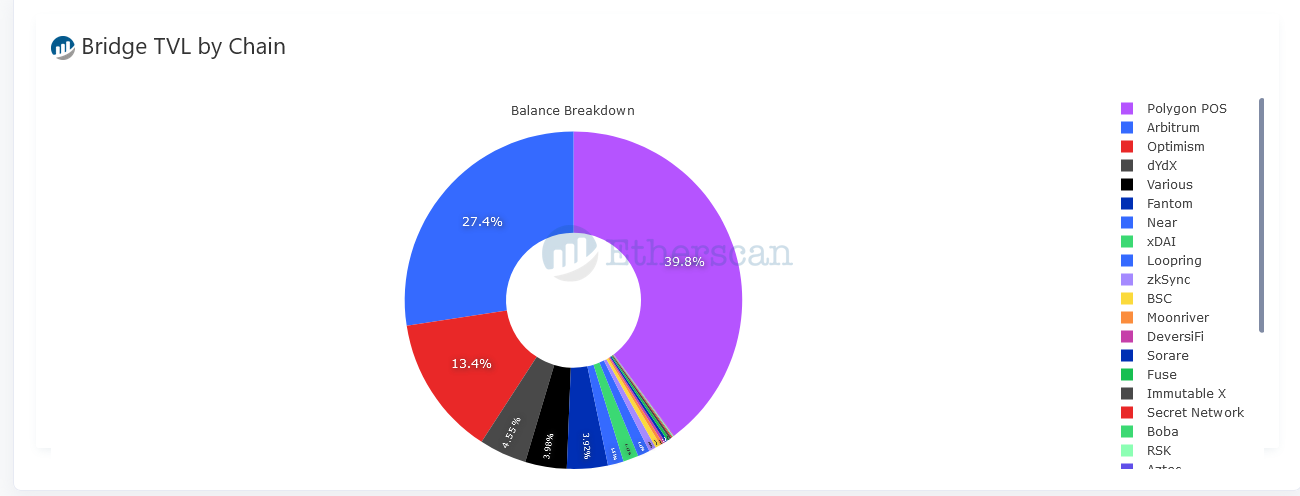Latest news about Bitcoin and all cryptocurrencies. Your daily crypto news habit.
The Ethereum-Polygon ERC-20 bridge is the most active, data on January 23 reveals.
Polygon-Ethereum Bridge Dominant
As of January 23, there were $2.18 billion of assets locked in the Ethereum-Polygon ERC-20 Bridge, almost twice the value of assets locked between the Ethereum and Arbitrum bridge which, at the time of writing, stood at $1.36 billion. Another Plasma bridge, connecting Ethereum and Polygon, is also the third most active, locking over $894 million as of press time.
The Arbitrum: L1 Custom Gateway, Arbitrum: L1 ERC20 Gateway, the Optimism: Gateway; and the Polygon (Matic): Ether Bridge connectors locked significant amounts of tokens. Meanwhile, dYdX: L2 Perpetual Smart Contract; Synthetix: L2 Deposit Escrow; and AnySwap: Fantom Bridge were the other links that capped the top 10 most active.
Bridges are essential for ETH. Since the blockchain is not inherently interoperable, unlike most competing blockchains designed using the Cosmos Core, bridges are indispensable for a functional ecosystem benefiting end users.
Most protocols strive to connect their ecosystems to ETH. As of late January 2023, the pioneer smart contracting platform was the most active layer-1, dominating DeFi and NFT activity.
There is also a large community of gaming and the metaverse taking advantage of Ethereum’s first mover advantage and vibrant community.
The platform’s native token, ETH, is the second most valuable, commanding a market capitalization of $199,974,616,120. According to trackers, each coin changes hands at $1,633.95 when writing.
Bridges Bring Interoperability
By linking to Ethereum, the community benefits from the resulting interoperability and connectivity. It is especially so because ETH is, by default, not interoperable.
Therefore, while billions of assets are locked in DeFi and NFT platforms, other ecosystems that might be active and trying to link their communities may only succeed with secure bridges.
Besides moving value between blockchains, Bridges are also beneficial in transferring vital data. Through data fluidity, developers in Ethereum or other connecting platforms can unlock new features and use cases.
Secure bridges can effectively expand the design space for what protocols offer. Besides, it will be possible for users to leverage strengths in other networks that might be absent in Ethereum.
Polygon, Arbitrum, and Optimism are all ETH layer-2 protocols. They are purposely designed to take advantage of Ethereum’s mainnet properties but offer relatively low fees and high scalability. Therefore, this means protocols deploying on Arbitrum and Optimism, taking advantage of these platforms’ rollups, or Polygon’s sidechain would technically access ETH dApps.
This interoperability would, in essence, also drive mainnet activity since users won’t have to make drastic changes. For example, they can still connect to the compatible layer-2 platform using MetaMask as they go about their DeFi, gaming, or metaverse activities.
Disclaimer
The views and opinions expressed in this article are solely those of the authors and do not reflect the views of Bitcoin Insider. Every investment and trading move involves risk - this is especially true for cryptocurrencies given their volatility. We strongly advise our readers to conduct their own research when making a decision.

